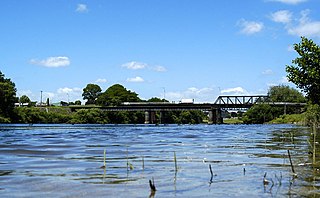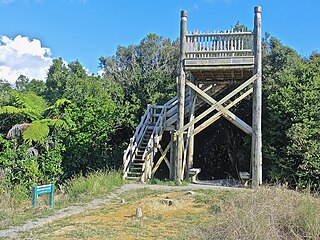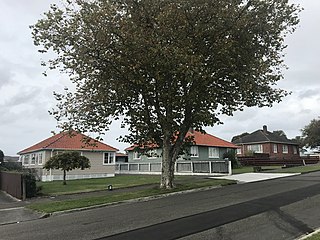
Massey University is a university based in Palmerston North, New Zealand, with significant campuses in Albany and Wellington. Massey University has approximately 30,883 students, 13,796 of whom are extramural or distance-learning students, making it New Zealand's second largest university when not counting international students. Research is undertaken on all three campuses, and more than 3,000 international students from over 100 countries study at the university.

Palmerston North is a city in the North Island of New Zealand and the seat of the Manawatū-Whanganui region. Located in the eastern Manawatu Plains, the city is near the north bank of the Manawatu River, 35 km (22 mi) from the river's mouth, and 12 km (7 mi) from the end of the Manawatu Gorge, about 140 km (87 mi) north of the capital, Wellington. Palmerston North is the country's eighth-largest urban area, with an urban population of 81,500.

Ngāruawāhia is a town in the Waikato region of the North Island of New Zealand. It is located 20 kilometres (12 mi) north-west of Hamilton at the confluence of the Waikato and Waipa Rivers, adjacent to the Hakarimata Range. Ngāruawāhia is in the Hamilton Urban Area, the fourth largest urban area in New Zealand. The location was once considered as a potential capital of New Zealand.

Hakarimata Range is a range of hills on the western edge of Ngāruawāhia township, in the Waikato region of New Zealand, overlooking the confluence of the Waikato and Waipa Rivers. The Hakarimata Range is separated from the Taupiri Range by the Taupiri Gorge, through which the Waikato River flows.

The Manawatū River is a major river of the lower North Island of New Zealand. The river flows from the Ruahine Ranges, through both the Manawatū Gorge and the city of Palmerston North, and across the Manawatū Plains to the Tasman Sea at Foxton.

Roslyn is a suburb in the city of Palmerston North, Manawatū-Whanganui, New Zealand.
Kelvin Grove is a suburb of Palmerston North on New Zealand's North Island. It is bounded on the north by the North Island Main Trunk railway, Manawatu District and Milson, on the west by Palmerston North–Gisborne Line and Roslyn, the south by the Manawatu River, and the east by James Line and Whakarongo.
Hokowhitu is a riverside suburb of the New Zealand city of Palmerston North, with some of the highest property values in the city.
Papaioea is a suburb of Palmerston North on New Zealand's North Island.

West End is a suburb of the New Zealand city of Palmerston North.
Whakarongo is a suburb of Palmerston North, New Zealand, between the city and Ashhurst. It is mainly rural, and features many vegetable gardens.

Caccia-Birch House is a New Zealand colonial homestead and a Heritage New Zealand Category I Historic Place. It is located at 130 Te Awe Awe Street in the city of Palmerston North. Completed in 1892, it is named after William Caccia Birch and his wife Maude, who gifted the property to the government in 1941.

Waimate is a town in Canterbury, New Zealand and the seat of Waimate District. It is situated just inland from the eastern coast of the South Island. The town is reached via a short detour west when travelling on State Highway One, the main North/South road. Waimate is 45.7 km south of Timaru, Canterbury's second city, 20 km north of the Waitaki River, which forms the border between Canterbury and the Otago province to the south and 47.5 km north of Oamaru, the main town of the Waitaki District.

Awapuni railway station was a station in Kairanga County, on the Foxton Branch and, from 1908, the North Island Main Trunk in New Zealand, now in the Palmerston North suburb of Awapuni. It was beside the Mangaone Stream, near its confluence with the Kawau Stream, about 400 m (440 yd) west of Maxwells Line on the north side of Pioneer Highway. Nothing remains of the former station, except a wide verge, partly occupied by a cycleway, built in 2015.

The 2014 Eketahuna earthquake struck at 3:52 pm on 20 January, centred 15 km east of Eketahuna on the south-east of New Zealand's North Island. It had a maximum perceived intensity of VII (severe) on the Mercalli intensity scale. Originally reported as magnitude 6.6 on the Richter Scale, the earthquake was later downgraded to a magnitude of 6.2. A total of 1112 aftershocks were recorded, ranging between magnitudes 2.0 and 4.9 on the Richter Scale.

Tangi William Edward Utikere is a New Zealand politician, and Member of Parliament for Palmerston North since 2020. He was the deputy mayor of Palmerston North from 2016 to 2020, being the first non-European to serve in that role.
Newbury is a rural community in Palmerston North City and Manawatu District, in the Manawatū-Whanganui region in New Zealand's central North Island.
Rangiotu is a farming community in the Manawatu District and Manawatū-Whanganui region in New Zealand's central North Island.
Ballance is a farming community in Tararua District and Manawatū-Whanganui region of New Zealand's North Island. The main settlement is located on the west back of the Mangahao River, south and west of Woodville and 11 km north-west of Pahiatua.

The Whakarongo Railway Station was a passenger rail station on the Palmerston North to Gisborne line, in the suburb of Whakarongo in the north of Palmerston North. The station was situated between the Terrace End Station and Ashhurst Station.














